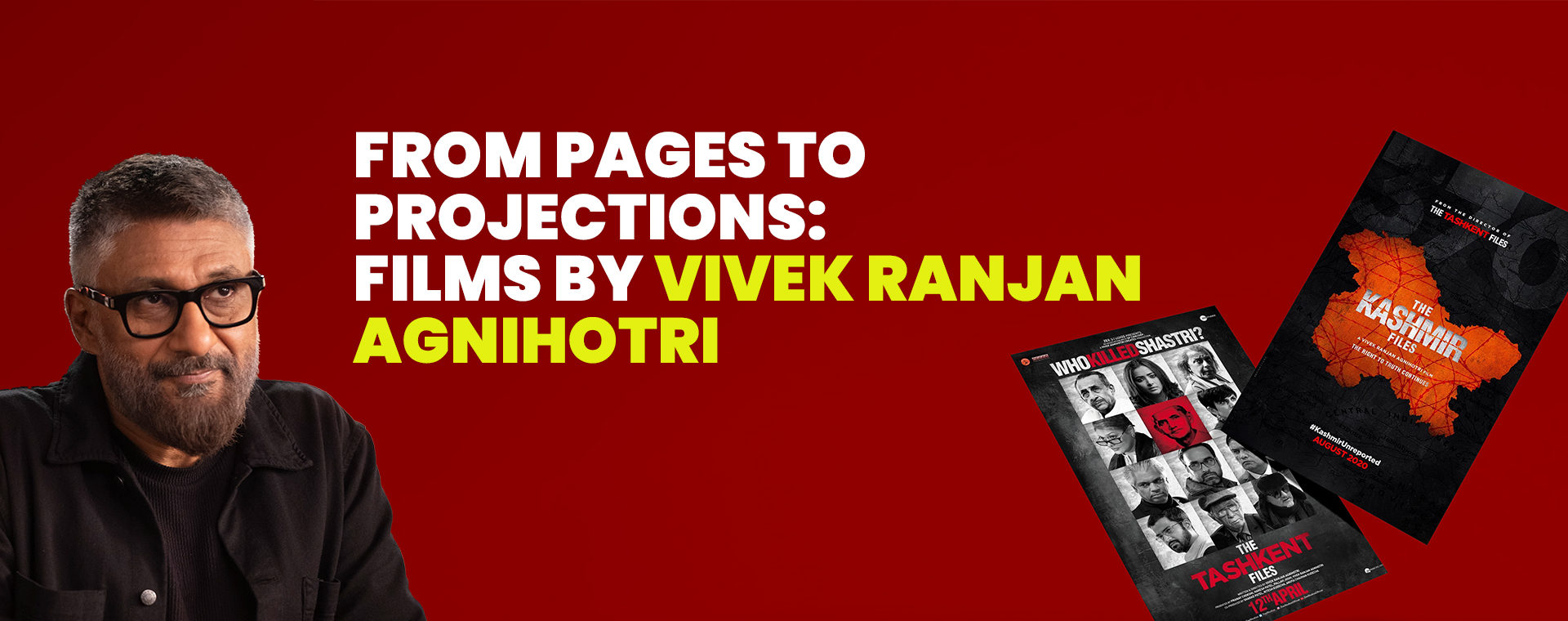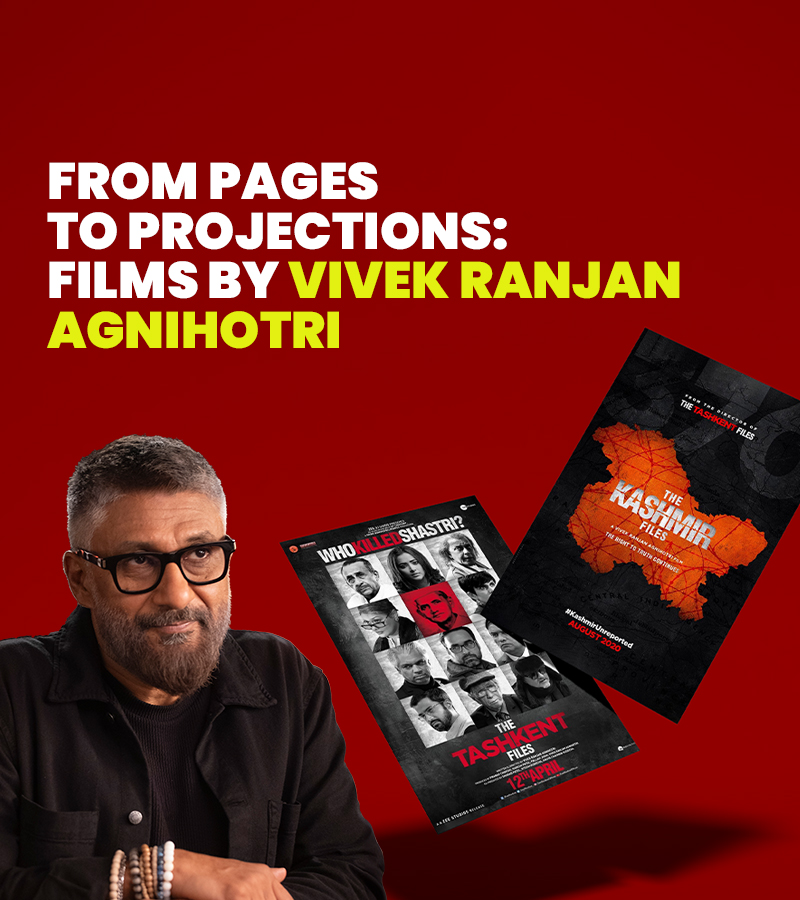

From Bookshelves to Box Office: Films by Vivek Ranjan Agnihotri
Step behind the curtain into Vivek Ranjan Agnihotri’s world, where the magic of books meets the silver screen’s glow.
The Spark That Starts It All
Every movie begins with a spark, an idea that yearns to be showcased on the grand stage of the silver screen. For many films, that spark ignites from the pages of a book. This process of metamorphosing cherished books into movies is a spellbinding journey. It’s not just about breathing life into stories; it’s about making them pirouette, sing, and reverberate in the hearts of viewers worldwide. But what does it take to select the right book? It commences with unearthing stories that have already ensnared imaginations, themes that reverberate in today’s world, and visuals that clamor to be witnessed. Books like Vivek Ranjan Agnihotri’s are a treasure trove of such narratives, brimming with tales that challenge, entertain, and enlighten.
The Road from Page to Screen
Adapting a book into a movie is a voyage filled with anticipation and hurdles. It’s about distilling the soul of a story, fitting grand narratives into the compact format of cinema. Screenwriters embark on the delicate task of pruning stories, deciding what’s pivotal for the narrative and what can be left to the audience’s imagination. It’s a tightrope walk between staying true to the book and crafting a film that stands tall. Vivek Ranjan Agnihotri’s opulent and comprehensive works present unique challenges and opportunities for screenwriters, calling for creativity and reverence for the original material.
The Process: A Step-by-Step Look
Selection of Material: Identifying a story that has the potential to translate well on screen is a crucial step. Vivek’s works are often chosen for their depth, relevance, and visual potential. The selection process involves considering the story’s universal appeal, its ability to resonate with a wide audience, and its potential for visual storytelling.
Screenplay Development: Converting the book into a screenplay that captures the essence of the story within a cinematic framework. This involves collaboration and a deep understanding of both mediums.
Creative Vision: Directors and cinematographers work to develop a visual style that complements the narrative, drawing on Vivek’s detailed descriptions and thematic elements.
Casting and Production: Finding actors who authentically embody the characters and a production team that can bring the story’s setting to life.
Post-Production: Editing, scoring, and special effects are added to enhance the storytelling, ensuring the final product is polished and impactful.
Audience Engagement: The film is released, and its success is determined by how well it resonates with audiences and critics alike. The audience’s feedback and reactions play a significant role in shaping the future of the adaptation process. Their engagement, whether positive or negative, provides valuable insights for filmmakers and authors.
Advantages of Adapting Books into Films:
Broader Audience: Films can introduce Vivek’s stories to those who might not be avid readers, expanding the audience.
Visual Impact: Cinema brings visual and auditory elements to storytelling, offering a different experience than reading a book.
Economic Benefits: Successful film adaptations can boost book sales and vice versa, benefiting publishers, authors, and filmmakers. This symbiotic relationship between books and films can lead to increased revenue for all parties involved. Additionally, successful adaptations can open doors for new projects and collaborations, further enhancing the economic benefits.
Creative Collaborations: The adaptation process allows for innovative collaborations, bringing together talented individuals from various fields.
New Interpretations: Films can offer new perspectives on a story, highlighting themes or characters in different lights.
Disadvantages of Adapting Books into Films:
Lost in Translation: Some nuances and internal monologues from the book may translate poorly into film, potentially diluting the story’s depth.
Creative Differences: Authors and filmmakers might have different visions for the story, leading to conflicts or compromises that affect the adaptation’s fidelity.
Fan Expectations: Die-hard fans of the book might be disappointed if the film deviates from their expectations, impacting reception.
Oversimplification: To fit into a standard film length, complex plots, and character development may be oversimplified, losing some of the original’s richness.
Economic Risks: Film production is costly, and not all adaptations recoup their investments, posing a financial risk.
Vivek’s Vision: From Words to Cinema
Vivek Ranjan Agnihotri is not just an author; he’s a visionary who bridges the gap between literature and cinema. His stories, often grounded in intense research and deep cultural insights, are a goldmine for cinematic adaptation. His involvement in the film adaptations of his works, whether as a writer, director, or producer, ensures that the essence of his stories is preserved while also embracing the creative liberties that cinema affords. This collaboration is crucial, as it allows the adaptation to maintain the soul of the book while flourishing in film.
Crafting the Script: The First Hero
In the heart of every film adaptation lies the screenplay, a blueprint that transforms written words into visual poetry. Screenwriters play the pivotal role of interpreters, translating complex narratives and characters into scenes that captivate and engage. Dialogue becomes sharper, scenes more focused, and characters more vivid. In adapting Vivek’s works, screenwriters must navigate the depth of his themes and the complexity of his narratives while crafting a script that resonates with both fans of the books and newcomers to his stories.
Painting with Light and Shadow
Cinema is visual storytelling, and adapting a book demands a keen eye for visual drama. Directors and cinematographers collaborate to bring the story’s setting and characters to life, using everything from the grandeur of landscapes to the subtlety of lighting to create the mood and tone of the film. With their intricate plots and rich settings, Vivek Ranjan Agnihotri’s stories offer a canvas that demands creative and innovative visual interpretation. In this adaptation stage, the film begins to diverge from the book, creating its own identity while honoring the source material.
Vivek’s Unique Touch
Vivek’s involvement in the cinematic adaptations of his works ensures a unique touch that’s rare in film adaptations. His insight into the characters, story, and underlying themes provides a guiding light for filmmakers, ensuring that the adaptations remain faithful to the spirit of the original while exploring new dimensions brought forth by the cinematic form. His films, such as ‘The Tashkent Files’ and ‘The Kashmir Files’, showcase his ability to weave compelling, thought-provoking, and visually stunning narratives. His unique touch can be seen in the way he brings his characters to life, the way he handles complex themes, and the way he balances faithfulness to the book with the demands of the cinematic medium.
Audience’s Verdict: The Ultimate Test
The triumph of a film adaptation ultimately rests in the hands of the audience. Will they embrace the cinematic interpretation of their beloved books? Vivek Ranjan Agnihotri’s adaptations stand as a testament to the potency of collaborative creativity, often meeting and surpassing audience expectations. These films beckon new fans to his books and ignite meaningful conversations, showcasing the power of cinema to enlighten, entertain, and inspire. The audience’s verdict is the ultimate test, and their embrace of the adaptation is a testament to the power of storytelling.
Conclusion: A Celebration of Storytelling
The journey from script to screen, especially for the adaptations of Vivek Ranjan Agnihotri’s works, celebrates storytelling in all its forms. It’s about taking the essence of a book and reimagining it for the cinema, creating a new work of art that stands alongside the original as a testament to the power of narrative. As we look forward to more of Vivek’s works making their cinematic debut, we’re reminded of the magic of literature and film colliding, creating new experiences, memories, and dialogues. Ultimately, the adaptation process is not just about preserving the story but expanding its reach, ensuring that it continues to resonate with audiences worldwide.






